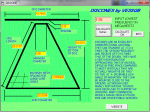As I've gained more equipment (now an SDR which I use for ADS-B and ACARS) and my pro 2006 for NOAA APT i've started experimenting more with building my own antennas (Such as a double cross for APT).
Well, I decided I wanted to do a little more, get a little bit more technical. I looked at the off the shelf stuff and thought that I should be able to build something for about as much as a new diamond, plus building teaches me more, and it half the fun.
**ABOUT THE ANTENNA**
I have all the images hosted in this album here >> Discone Antenna - Imgur
I created the antenna out of 6061 Aluminum round stock and threaded 3/8" rods.
* The disc is 1.50" and the cone is 2.25" stock taperd to 60 degrees. * Each disc element is 18" and the cone rods are 24"
* The insulator is made from a 1/4 fernco cap which I cut off the sides (plumbing fitting). 16 elements in each section.
* A uhf connector is run though the bottom of the cone and it's put together with machine screws, running from disc to cone section but insulated by flexible pvc inserts to keep it from shorting.
I plan on painting the entire unit to seal it best I can, as well as locktight threads in place. Discones are very high gain from what I can gather, and I know this needs tweaked. I plugged in to my SDR receiver just to get a base and it rose the noise floor quite a bit more than it is right now with my RS discone on it, but that is possible because it's in the house instead of outside. Also, I plugged in my pro 106 scanner, the p25 from the local PD came in much more clear than I've heard it before.
I know the insulator has a large effect on the so that's something I'm considering modifying before it goes to it's final place on my roof. Additionally I'm thinking about adding a center element on top tuned for CB. I'm also not sure if the disc being .75" smaller than the cone is an issue. Thoughts?
TL;DR - Aspiring rf engineer (ha) builds first major antenna, wanted to share.
Well, I decided I wanted to do a little more, get a little bit more technical. I looked at the off the shelf stuff and thought that I should be able to build something for about as much as a new diamond, plus building teaches me more, and it half the fun.
**ABOUT THE ANTENNA**
I have all the images hosted in this album here >> Discone Antenna - Imgur
I created the antenna out of 6061 Aluminum round stock and threaded 3/8" rods.
* The disc is 1.50" and the cone is 2.25" stock taperd to 60 degrees. * Each disc element is 18" and the cone rods are 24"
* The insulator is made from a 1/4 fernco cap which I cut off the sides (plumbing fitting). 16 elements in each section.
* A uhf connector is run though the bottom of the cone and it's put together with machine screws, running from disc to cone section but insulated by flexible pvc inserts to keep it from shorting.
I plan on painting the entire unit to seal it best I can, as well as locktight threads in place. Discones are very high gain from what I can gather, and I know this needs tweaked. I plugged in to my SDR receiver just to get a base and it rose the noise floor quite a bit more than it is right now with my RS discone on it, but that is possible because it's in the house instead of outside. Also, I plugged in my pro 106 scanner, the p25 from the local PD came in much more clear than I've heard it before.
I know the insulator has a large effect on the so that's something I'm considering modifying before it goes to it's final place on my roof. Additionally I'm thinking about adding a center element on top tuned for CB. I'm also not sure if the disc being .75" smaller than the cone is an issue. Thoughts?
TL;DR - Aspiring rf engineer (ha) builds first major antenna, wanted to share.


